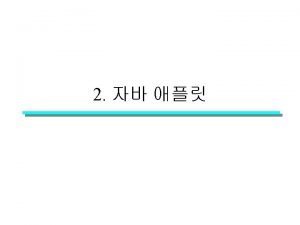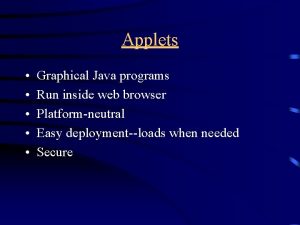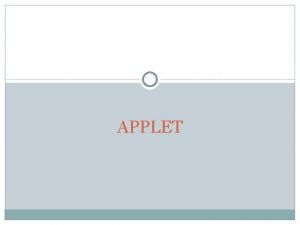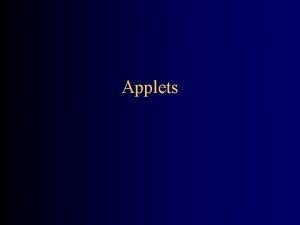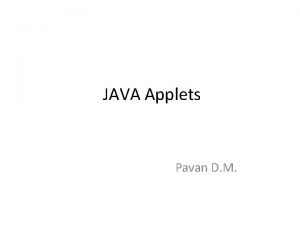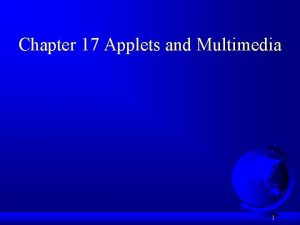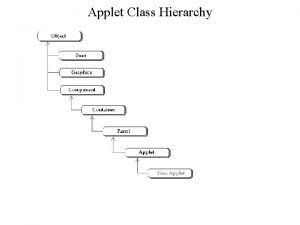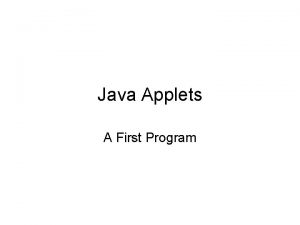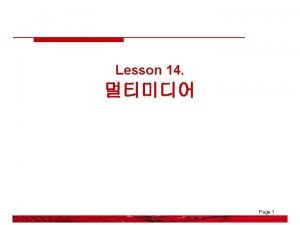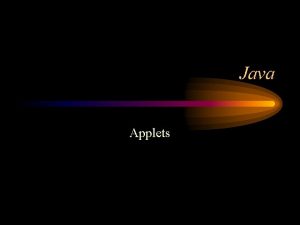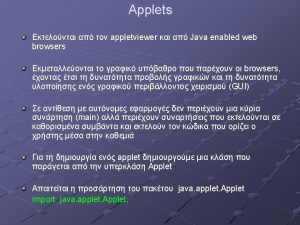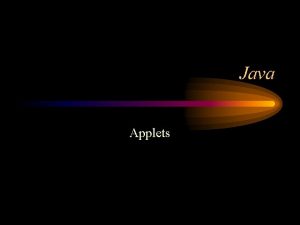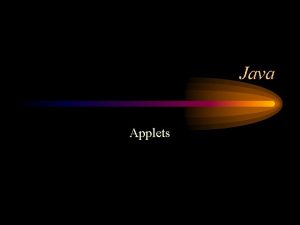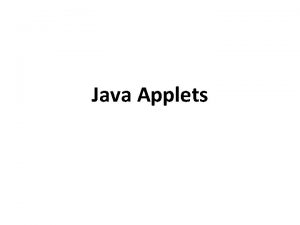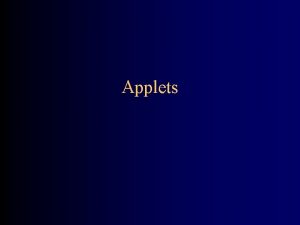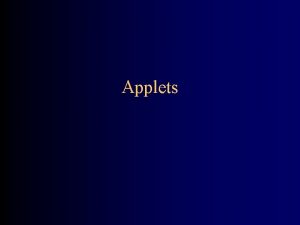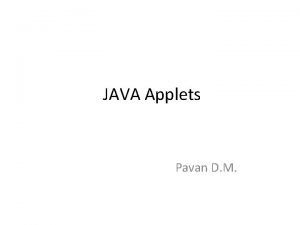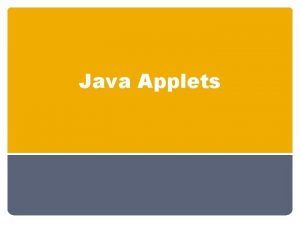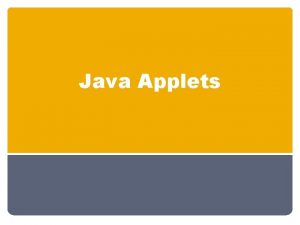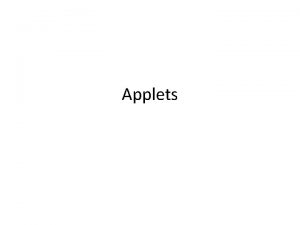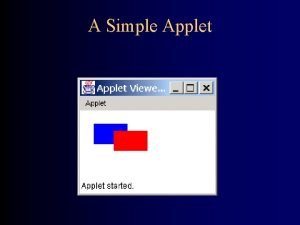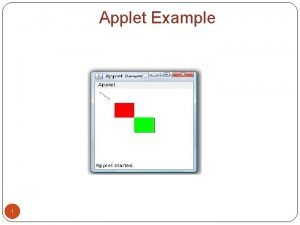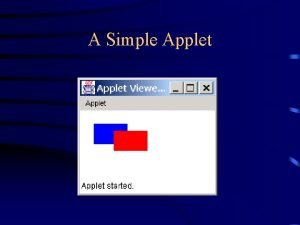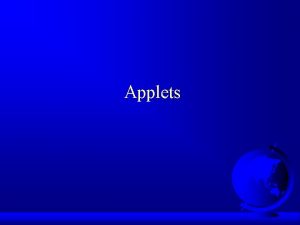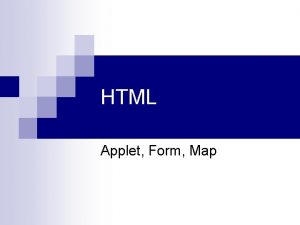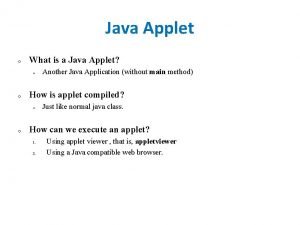Java Applets Applets An applet is a Panel
























- Slides: 24

Java Applets

Applets • An applet is a Panel that allows interaction with a Java program. • A applet is typically embedded in a Web page and can be run from a browser. • You need special HTML in the Web page to tell the browser about the applet. • Applets run in a sandbox: they have no access to the client’s file system.

Applet Support • Netscape claims to support Java 1. 1, but has serious omissions. • MS Internet Explorer supports most of 1. 1. • The best support isn't a browser, but the standalone program appletviewer. • In general you want to write applets that can be run with any browser

What an applet is • You write an applet by extending the class Applet. • Applet is just a class like any other; you can even use it in applications if you want. • When you write an applet, you are only writing part of a program. • The browser supplies the main program.

The genealogy of Applet java. lang. Object | +----java. awt. Component | +----java. awt. Container | +----java. awt. Panel | +----java. applet. Applet

The simplest possible applet Trivial. Applet. java import java. applet. Applet; public class Trivial. Applet extends Applet { } Trivial. Applet. html <applet code="Trivial. Applet. class” width=150 height=100> </applet>

The simplest reasonable applet import java. awt. *; import java. applet. Applet; public class Hello. World extends Applet { public void paint( Graphics g ) { g. draw. String( "Hello World!", 30 ); } }

Applet methods • • • public void init () public void start () public void stop () public void destroy () public void paint (Graphics g)

Why an applet works • You write an applet by extending the class Applet. • Applet defines methods init( ), start( ), stop( ), paint(Graphics), destroy( ) • These methods do nothing--they are stubs. • You make the applet do something by overriding these methods.

public void init ( ) • This is the first method to execute • It is an ideal place to initialize variables • It is the best place to define and use buttons, text fields, sliders, layouts, etc. • Almost every applet you ever write will have an init( ) method

public void start ( ) • Not always needed • Called after init( ) • Called each time the page is loaded and restarted • Used mostly in conjunction with stop( )

public void stop( ) • • Not always needed Called when the browser leaves the page Called just before destroy( ) Use stop( ) if the applet is doing heavy computation that you don’t want to continue when the browser is on some other page • Used mostly in conjunction with start()

public void destroy( ) • Seldom needed • Called after stop( ) • Use to explicitly release system resources (like threads) • System resources are usually released automatically

Applet flow of control

public void paint(Graphics g) • Almost always needed • Any painting you want to do should be done here, or in a method you call from here • Painting that you do in other methods may or may not happen • Don’t call this method. It’s called automatically. • Call repaint( ) instead.

Sample Graphics methods • • • A Graphics is something you can paint on. g. draw. String(“Hello, World”, 20); g. draw. Rect(x, y, width, height); g. fill. Rect(x, y, width, height); g. draw. Oval(x, y, width, height); g. fill. Oval(x, y, width, height); g. set. Color(Color. red);

repaint( ) • Call repaint( ) when you have changed something and want your changes to show up on the screen • repaint( ) is a request--it might not happen. • When you call repaint( ), Java schedules a call to update(Graphics g).

update( ) • When you call repaint( ), Java schedules a call to update(Graphics g) • Here's what update does: public void update(Graphics g) { // Fill applet with background color paint(g); }

Other useful Applet methods • System. out. println(String s) still works. • Automatically opens an output window. • show. Status(String) displays the String in the applet’s status line. • Each call overwrites the previous call. • You have to allow time to read the line!

Applets are not magic! • Anything you can do in an applet, you can do in an application. • You can do some things in an application that you can’t do in an applet. • If you want to access files from an applet, it must be a “trusted” applet. • Trusted applets are beyond the scope of this course.

Structure of an HTML page HTML HEAD BODY TITLE (content) • Most HTML tags are containers. • A container is <tag> to </tag>

HTML <html> <head> <title> Hi World Applet </title> </head> <body> <applet code="Hi. World. class” width=300 height=200> <param name=arraysize value=10> </applet> </body> </html>

<param name=arraysize value=10> • public String get. Parameter(String name) • String s = get. Parameter(“arraysize”); • try { size = Integer. parse. Int (s) } catch (Number. Format. Exception) {…}

The End
 자바 애플릿
자바 애플릿 Import java.applet.applet
Import java.applet.applet Java applet swing
Java applet swing Import java.applet.applet
Import java.applet.applet Java applet class
Java applet class Import java.applet.applet
Import java.applet.applet Tanslate
Tanslate Difference between local applet and remote applet
Difference between local applet and remote applet An applet is a of panel
An applet is a of panel Zıt panel
Zıt panel Continuous panel vs discontinuous panel
Continuous panel vs discontinuous panel Html applet tag
Html applet tag Moving ball program in java using applet
Moving ball program in java using applet Hierarchy of applet in java
Hierarchy of applet in java Java applet example
Java applet example @games_comp
@games_comp Java applet testing
Java applet testing Import java.applet.*
Import java.applet.* Applet program in java
Applet program in java Java applet program draw cartoon
Java applet program draw cartoon Applet structure in java
Applet structure in java Java applet hello world
Java applet hello world Erik poll
Erik poll Wisweb applets
Wisweb applets Wisweb applets
Wisweb applets
